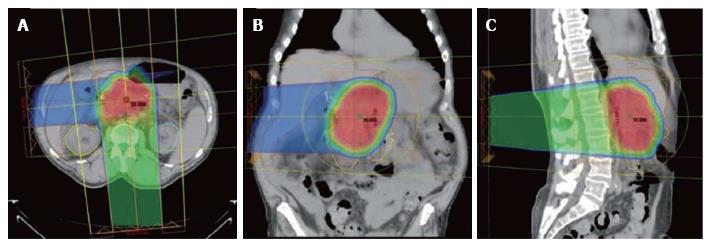Copyright
©The Author(s) 2017.
World J Gastrointest Surg. Apr 27, 2017; 9(4): 103-108
Published online Apr 27, 2017. doi: 10.4240/wjgs.v9.i4.103
Published online Apr 27, 2017. doi: 10.4240/wjgs.v9.i4.103
Figure 3 Typical proton dose distributions used to treat pancreatic cancers.
Shown in the axial (A), coronal (B), and sagittal (C) projections. A heavily weighted (75% of the target dose) posterior or posterior oblique field is combined with a more lightly weighted (25% of the target dose) right lateral oblique field. Because protons are associated with a low entry dose and no exit dose compared with X-rays, there is significant sparing of small bowel and stomach tissue, which are highly sensitive to radiation damage. This normal-tissue sparing explains the low incidence of gastrointestinal toxicity when protons are used to deliver upper abdominal radiotherapy.
- Citation: Hitchcock KE, Nichols RC, Morris CG, Bose D, Hughes SJ, Stauffer JA, Celinski SA, Johnson EA, Zaiden RA, Mendenhall NP, Rutenberg MS. Feasibility of pancreatectomy following high-dose proton therapy for unresectable pancreatic cancer. World J Gastrointest Surg 2017; 9(4): 103-108
- URL: https://www.wjgnet.com/1948-9366/full/v9/i4/103.htm
- DOI: https://dx.doi.org/10.4240/wjgs.v9.i4.103









